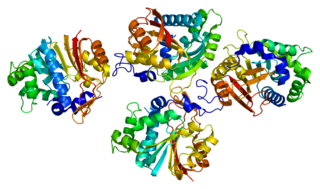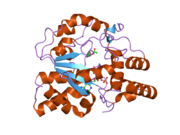In enzymology, an aryl-sulfate sulfotransferase is an enzyme that catalyzes the chemical reaction
An aryl sulfotransferase is an enzyme that transfers a sulfate group from phenolic sulfate esters to a phenolic acceptor substrate.

Sulfotransferase 1A1 is an enzyme that in humans is encoded by the SULT1A1 gene.

Sulfotransferase 1A3/1A4 is an enzyme that in humans is encoded by the SULT1A3 gene.

Estrogen sulfotransferase is an enzyme that in humans is encoded by the SULT1E1 gene.

Sulfotransferase family cytosolic 2B member 1 is an enzyme that in humans is encoded by the SULT2B1 gene.

Sulfotransferase 1C2 is an enzyme that in humans is encoded by the SULT1C2 gene.

Nicotinamide N-methyltransferase (NNMT) is an enzyme that in humans is encoded by the NNMT gene. NNMT catalyzes the methylation of nicotinamide and similar compounds using the methyl donor S-adenosyl methionine (SAM-e) to produce S-adenosyl-L-homocysteine (SAH) and 1-methylnicotinamide.

Sulfotransferase 4A1 is an enzyme that in humans is encoded by the SULT4A1 gene.

Carbohydrate sulfotransferase 4 is an enzyme that in humans is encoded by the CHST4 gene.

Sulfotransferase family cytosolic 1B member 1 is an enzyme that in humans is encoded by the SULT1B1 gene.

Carbohydrate sulfotransferase 15 is an enzyme that in humans is encoded by the CHST15 gene. It belongs to the N-acetylgalactosamine 4-sulfate 6-O-sulfotransferase enzyme class.

Galactose-3-O-sulfotransferase 2 is an enzyme that in humans is encoded by the GAL3ST2 gene.

Heparan sulfate glucosamine 3-O-sulfotransferase 3A1 is an enzyme that in humans is encoded by the HS3ST3A1 gene.

Sulfotransferase 1C4 is an enzyme that in humans is encoded by the SULT1C4 gene.

Heparan sulfate glucosamine 3-O-sulfotransferase 2 is an enzyme that in humans is encoded by the HS3ST2 gene.

Bile salt sulfotransferase also known as hydroxysteroid sulfotransferase (HST) or sulfotransferase 2A1 (ST2A1) is an enzyme that in humans is encoded by the SULT2A1 gene.

Sulfotransferase 1C3, also known as ST1C3, is an enzyme that in humans is encoded by the SULT1C3 gene.

In biochemistry, carbohydrate sulfotransferases are enzymes within the class of sulfotransferases which catalyze the transfer of the sulfate functional group to carbohydrate groups in glycoproteins and glycolipids. Carbohydrates are used by cells for a wide range of functions from structural purposes to extracellular communication. Carbohydrates are suitable for such a wide variety of functions due to the diversity in structure generated from monosaccharide composition, glycosidic linkage positions, chain branching, and covalent modification. Possible covalent modifications include acetylation, methylation, phosphorylation, and sulfation. Sulfation, performed by carbohydrate sulfotransferases, generates carbohydrate sulfate esters. These sulfate esters are only located extracellularly, whether through excretion into the extracellular matrix (ECM) or by presentation on the cell surface. As extracellular compounds, sulfated carbohydrates are mediators of intercellular communication, cellular adhesion, and ECM maintenance.
Phenol sulfur transferase deficiency, in short PST deficiency, is the lack or the reduced activity of the functional enzyme phenol sulfur transferase, which is crucial in the detoxification of mainly phenolic compounds by catalysing the sulfate conjugation of the hydroxyl groups in the toxic phenolic compounds to result in more hydrophilic forms for more efficient excretion. This metabolic disorder was first discovered in the late 1990s by Dr. Rosemary Waring during her researches with autistic children, which also made this deficiency commonly associated to the topics of autism. Mutations in the PST genes account for the genetic causes of the deficiency, of which single nucleotide polymorphism and methylation of promoters are two examples of mutations that respectively cause conformational abnormalities and diminished expressions to the enzyme, resulting in the reduced detoxification of phenolic compounds and regulation of phenolic neurotransmitter. The deficiency may cause symptoms like flushing, tachycardia, and depression, and be a risk factor for disorders like autism, migraine, and cancer, while it also limits the use of phenolic drugs in PST deficient patients. There is currently no drug available for treating PST deficiency. However, some people suffering from PST deficiency have found taking a digestive enzyme supplement containing Xylanase 10 minutes before eating to greatly reduce symptoms.






















